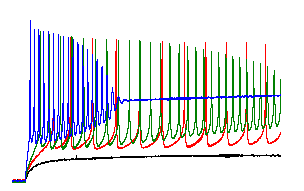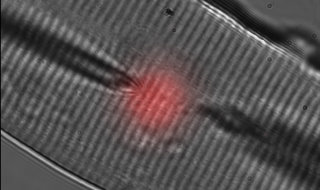
| Home | Projects | personnel | publications | Resources | links | contact |
|
|
Welcome to the Vergara Lab…
Our laboratory investigates the excitation-contraction (EC) coupling process in mammalian skeletal muscle using a combination of electrophysiological, molecular genetics, and optical tools.
The rationale behind our approach is based on the concept that the overall mechanical performance of skeletal muscles operating under voluntary control is critically determined by the ability of individual muscle fibers to respond quickly to electrical signals generated in the CNS with electrical and chemical changes of their own. How quickly? We know that after the arrival of the nerve action potential (AP), and a brief synaptic delay of a fraction of a millisecond, the muscle fiber fires an AP that propagates along its longitudinal axis. This is the first episode in the EC coupling chain of events that we are interested in. It involves the presence of ionic conductances present at the sarcolemma (Na, K and Cl) which are characteristic of muscle tissue. As the AP wave propagates longitudinally, it also spreads inwardly (in depth) throughout the membrane network that constitutes the transverse tubular system (T-system) in a process, akin a radial wave propagation, which also involves the presence of prevalent ionic conductances (e.g. Na, K delayed rectifier, Cl, and K-inward rectifier) in T-system membranes. What steps of the EC coupling process involves chemical changes? Though the AP propagation in the T-system is slightly slower than the longitudinal propagation of the AP, it still ensures that rapid changes in transmembrane potential (within milliseconds) are detected by a “voltage sensor,” which is ultimately responsible for triggering (through a much investigated signal transduction process) the opening of ryanodine receptor (RyR1) channels. The opening of the RyR1 Ca2+ channels, which are critically located at sarcoplasmic reticulum (SR) membranes facing the T-tubules (T-SR junctions), leaks Ca2+ from inside of the SR into the myoplasm and generates large [Ca2+] concentration gradients with maxima in the vicinity of T-tubules generating the so-called Ca2+ microdomains. The diffusion of Ca2+ ions away from these regions resembles a chemical wave that spreads through the sarcomere and reaches the region where troponin is located, thus initiating the contractile activation. We are particularly interested in the investigation of the mechanism of transduction at the T-SR junctions by which the depolarization of the T-tubules controls the activation of Ca2+ release from the SR, and the mechanisms by which the localized release of Ca2+ ions spreads throughout the sarcomere. What is the biomedical relevance of our investigations? An important aspect of our research is the focus on muscle diseases resulting from alterations in structural and ion channel proteins inasmuch they impact various steps in the EC coupling process. Thus, we are interested in the mechanisms by which the presence of dystrophin, a structural protein that is an essential part of the dystroglycan complex (DGC) in normal muscle, is crucial for the functional preservation of the EC coupling process. In other words, the question we are concerned with is, how does the alteration of the DGC in animal models, and in Duchenne (DMD) and Becker Muscular Dystrophy (BMD) patients, results in functional alterations of various steps in the EC coupling process? Another important biomedical problem that we actively investigate is how inherited ion channel defects which affect skeletal muscle lead to various channelopathies. Our goal is to explain, based on functional monitoring of the electrical activity in the TTS and evoked Ca2+ release from the SR, the pathophysiological causes underlying the muscle-specific phenomenology observed in various forms of periodic paralysis and myotonia. |
| Home | Projects | personnel | publications | Resources | links | contact |
|
Copyright Julio L. Vergara, PhD Website Designed & Mantained by Raul Serrano. |
Tel:+1(310)206-8160 Fax: +1(310)206-3788 |
| Website updated August 2012 |




